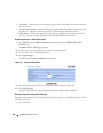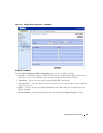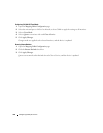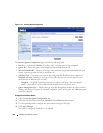
Configuring Quality of Service 639
•
Policy Name
— Displays the policy associated with the selected interface.
•
Operational Status
— Displays whether the policy is active or not on this interface.
•
Member Classes
— Selects the member class for which octet statistics are to display.
•
Offered Packets
— Displays how many packets match the policy.
•
Discarded Packets
— Displays how many packets are dropped by the policy.
Displaying Service Statistics
1.
Open the
Diffserv Service Detailed Statistics
page.
2.
Complete the fields as needed.
Packet statistics display for the specified interface, direction, and class.
Configuring Service Statistics Using the CLI Command
For information about the CLI command that performs this function, see the following chapter in the
CLI Reference Guide:
• QoS Commands
Class of Service
The Class of Service (CoS) queueing feature lets you directly configure certain aspects of switch
queueing. This provides the desired QoS behavior for different types of network traffic when the
complexities of DiffServ are not required. The priority of a packet arriving at an interface can be used to
steer the packet to the appropriate outbound CoS queue through a mapping table. CoS queue
characteristics that affect queue mapping, such as minimum guaranteed bandwidth, transmission rate
shaping, etc., are user-configurable at the queue (or port) level.
Seven queues per port are supported. Although the hardware supports eight queues, one queue is always
reserved for internal use by the stacking subsystem.
To display the page, click Quality of Service > Class of Service in the tree view. The Class of Service
menu page contains links to the following features:
• Mapping Table Configuration
• Interface Configuration
• Interface Queue Configuration


















